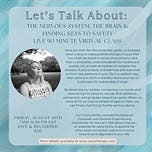Hi, and welcome back to Tiny Sparks. This week we have a little mini podcast episode. I like to change up the way I present the information to you, because some of us like to listen, some of us like to read, and the good thing is, with the podcast episode, if you don't want to listen, you can read the full transcript below.
So this week, I wanted to talk about something that comes up so frequently in therapy and healing work, which is the idea of self-sabotage. I see people all the time on social media talking about this, and very, very often the people I work with will come in and say, oh, I was making so much progress. And then I did this, this and this this weekend. And I'm just too self-sabotaging. And oftentimes the way that term self-sabotaging is used is it's very critical, it's very collapsing. It's this idea that I was doing good and now I'm bad. I'm sabotaging myself. And very often, what I want to support people in knowing is that it's not that you are “bad” or purposefully getting in your own way, but rather that a part of your brain is trying to protect you and keep you safe. That automatically shifts the lens from this collapsing blaming lens to this understanding of there's something deeper happening when we talk about self-sabotage.
People mean all kinds of things when they talk about self-sabotage. A lot of times people will talk about things like procrastination, oh, I landed this project that I'm really, really excited about, but instead of working on it this weekend, I scrolled on my phone and watched TV all weekend. I am self-sabotaging and always delaying things- I'm never following through. Self-sabotage can show up in other ways, too. Perfectionism can be a form of self-sabotage, where we set impossibly high standards for ourselves that we can never reach. But oftentimes, self-sabotage people mean that they're not on the path that they want to be on. So they'll say, well, I was really wanting to go to the gym every day to take care of my health, and I did it for three weeks. But then this weekend, I didn't go to the gym at all. I laid on the couch all day and I just ate snacks, and I didn't move, and I didn't even go on a walk. I'm just really self-sabotaging.
So first, there's this really problematic idea, which is that when we're wanting to make a change in our lives or to do something differently, or to move toward something different, that we have to be doing it exactly right every single day, or else we're not successful in that change. That, in its core, is a misunderstanding of how our brain works. When we're trying to make changes or move towards something we want that is new, that is different, that is something we haven't done before, we have to think about our brain and to understand that the things we have done repeatedly in our lives are like beautiful, paved highways in our brain. Our brain creates these patterns on based on what has happened to us in the past, so that it can predict what is going to happen in the future.
So you can kind of think of the roadways in a city. They're not going to make beautiful big paved highways out in the rural country where not a lot of people go. They might have one, two lane rural state highway. They're not going to have a big, beautiful, gorgeous 12 lane interstate. They make the interstates around the major cities where there are a lot of people going, and our brain works the same way. It builds these pathways to say, this is something that's happened in the past. It's likely something that will happen in the future. It's something that I need to be able to access regularly. So I will build a roadway around it. It doesn't matter whether it's something that we like, something we don't like. It's all about what is going to keep us safe, keep us going and what we do repeatedly. When you want to make a change in your brain, you are saying, I want to go off of this interstate highway that I drive on every single day, and I want to go out into the Amazon jungle. That's what it's like in the rest of our brain outside of these neural pathways and predictive patterns.
So when you're wanting to make a change in your life, you are basically getting off the interstate and you get off the exit, and not only is there not a road there, but there's a really, really dense, dense, dense jungle. So it's not realistic to expect that you're going to be able to make a sudden change, because when you get off the interstate and you're in the jungle, it's like, huh, I can't even I can't even drive my car. I'm gonna have to get out of my car and start walking and start hacking down vines. That's what it's like when we want to make a change in our brain. So you can see why. First off, it's simply unrealistic to expect that when we want to make a change, we're going to do the change every single time. Like maybe ten times you'd get in your car and you drive on the interstate, which is not going to the gym. And the 11th time you go out into the jungle, you start hacking down vines, and you do go to the gym. Very often when we start to make a change, we have some initial excitement about making the change, so we're able to override and just kind of go out into the jungle. But after a while, our brain gets fatigued and wants to go back to that old pathway of not going to the gym. In this example, it starts to get a lot deeper than that when we recognize that not only is our brain not wanting to go from the roadway into the jungle, but it's also trying to protect us and keep us safe.
The brain wants to maintain something called homeostasis. And homeostasis means keeping everything the same. It wants to do that because it doesn't want to expend extra energy trying to make changes all of the time. So it wants to stay on those familiar, comfortable highways. When we tried to disrupt the homeostasis by going against the same things that we have always done, the brain is going to say, whoa, whoa, whoa whoa whoa, pump the brakes. In a way, our brain will actively resist change. Then add the next level onto this: when we start to understand that these predictive pathways, these neural pathways in our brain formed to keep us safe based on what has happened to us in our earlier life. Then it gets even more complex.
So if you start to think about what in this example, what does going to the gym represent? Let's just say that going to the gym represents taking care of yourself, that you really want to be able to show up and take care of yourself. It doesn't matter if you walk ten minutes on the treadmill or you stretch or whatever it is, you just really want to start taking care of yourself more. Sounds great right? We're always talking about self-care and taking care of ourselves. What happens if in your early life what you learned is having needs made everyone upset? Maybe in your house what you learned was, when I have a need, when I want something, when I act out a little bit or I reach towards something that I want, everything in my house feels really tense. Maybe it's that your family didn't have a lot of money, so when you wanted something like to go on a field trip, it wasn't that your family didn't want to support you in that, but they just genuinely didn't have the funds. So there was a lot of tension, a lot of stress as your parents tried to figure out how to juggle that and make that work. Or maybe you had caregivers who just couldn't take care of their own needs. They didn't learn how to do that. And so then when you had a need or want or an emotion or an experience that made them feel really overwhelmed, so they pulled back from you, or they sent you to their room or whatever it is, or maybe you lived in an environment that was very emotionally volatile.
So you learn from a young age, having needs and wants was just an unsafe experience. Things already felt so much, so volatile, so unsure, that you just learned to keep your needs and wants shut down- to not take care of yourself, but to focus on taking care of and attuning to everyone else's needs around you. In each of these situations, what is happening is your brain is forming predictive patterns in your brain to say having a need, having a want, having an emotion, having needs, and not focusing on the needs of people around me is dangerous. And this is from the mind of usually a child, a younger part of us. Yes, we can experience this as adults too, but it oftentimes starts in our early environment where children don't have the cognitive complexity- or maybe as adults we don't have the safety- to choose and say, I want to do something differently. This isn't about me. The fact that my parents can't support my needs or my partner or whoever it is isn't about me. We might not have had that opportunity or the ability to do that, because we are so wired to stay in connection to our caregivers in our early life, but instead what we do is we just say, well, if I have to choose between my caregivers and me, I'm going to choose my caregivers. Because it just feels so unsafe to consider anything else. So boom, now you have this really well formed interstate highway in your brain that says choosing myself, having needs, attuning to myself, taking care of myself puts my connection with others at stake, which means it puts my life at stake.
Listen to this episode with a 7-day free trial
Subscribe to tiny sparks - trisha wolfe to listen to this post and get 7 days of free access to the full post archives.










